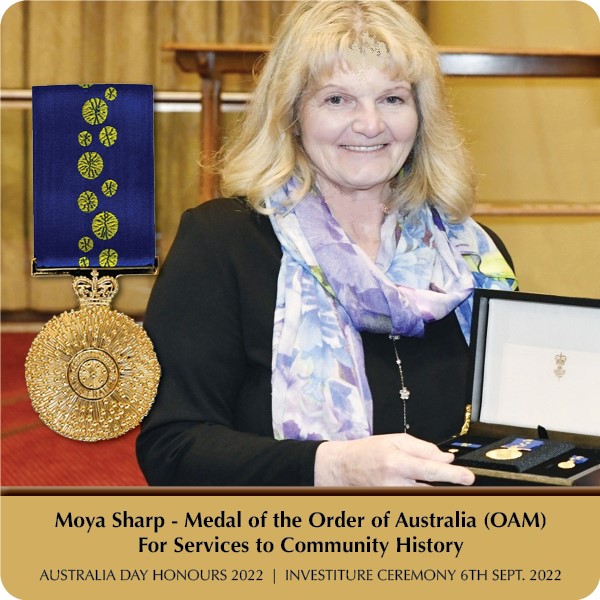- Aboriginal History
- Cemeteries
- Hospitals
- Hotels
- Maps of the Goldfields
- Military
- Miners
- Miscellaneous
- People
- Places on the Goldfields
- Place Index A-Z
This website is dedicated to the memory of my two dear friends Sandy Duncan and Shyama Peebles who both passed away in 2012.
Military > WW1 Soldiers - Mount Morgans
WW1 Soldiers - Enlisted or Born in Mount Morgans
For further details go to - https://www.awm.gov.au/
Clive Baron : Place of Birth, Birmingham England ; Place of Enlistment, Morgans WA ;
Next of Kin; Brother - Clive Clifford
Fleming Tom Joseph : Place of Birth, Mount Morgans WA ; Place of Enlistment, Fremantle WA ;
Next of Kin; Brother - ookin D.F.
Forsythe George Vincent[Gibson George]:Place of Birth, Mount Morgans WA:POE Melbourne VIC:NOK M Forsythe Alice
Researched by Dave Spain:-
MOUNT MORGANS
7095 Sapper Baron Clive was born in Birmingham England about December 1873. His NOK was his brother Clifford Clive and resided at 10 Hall Rd, Handsworth, Birmingham, England. He was 6 ft 2 ins (177 cm) tall and weighed 176 Lbs (80 Kg). He had a fair complexion with blue eyes and brown hair. He was single, and his religion was Church of England. He was a Prospector and worked in the Linden area.
SPR Clive enlisted on the 19th October 1916 at Mt Morgans. He attended his basic training at 92 Training Depot from the 1st November 1916 to the 30th November 1916. He was allocated to the Miners Reinforcements to complete training as a Tunnel Reinforcement at Seymore, Victoria, from the 19th January 1917 to 27th February 1917. On completion of the training he was allocated to the February Reinforcements of the 3rd Tunnelling Company of the AIF. SPR B Clive embarked on the HMAT A9 (Shropshire) from Melbourne on the 11th May 1917 and arrived in Plymouth, England on the 19th July 1917. During the voyage to England he contracted a bout of Influenza and was confined to the ship’s hospital from the 28th June 1917 to the 14th July 1917. On arrival at Plymouth he was transferred to the Devonport Military Hospital and was discharged fit on the 24th July 1917. On the 24th July 1917, he marched in to the No 1 Command Depot located at Devonport, Perham Downs. He was allocated to the Overseas training Depot on the 28th July 1917 and after further training proceeded to France via Southampton on the 12th September 1917.
He arrived at the Australian General Base Depot (AGBD) located at Rouelles on the 14th September 1917. He was sent to his Unit, the 3rd Tunnelling Company, on the same date.
7095 Sapper Baron Clive was admitted to the 2nd General Hospital at Le-Havre, France, on the 29th October 1917 with Influenza. At 0910 on the 6th November 1917 he died of Lobar Pneumonia and Cardiac Failure. He is buried in the STE. Marie Cemetery, at Le-Havre, France. Div.62. I.K.6. His medals have been claimed.
7299 PTE Tom Joseph Fleming was born at Mount Morgans, Western Australia, about June 1899. His NOK was DF Bodkin, a Guardian residing at Victoria Park, as both his parents were deceased. He was 5 ft 7 ins (161 cm) tall and weighed 133 lbs (60.5kg). He had a fair complexion with blue eyes and brown hair. He was single, and his religion was Roman Catholic. He was a farmhand.
PTE T Fleming enlisted on the 16th November 1917 at Fremantle, Western Australia. After attending basic training at Blackboy Hill, he was allocated to the 22nd Reinforcements of the 28th Infantry Battalion. Leave was granted during December 1917. On the 13th March 1918, Pte Fleming embarked for England from Fremantle on the RMS Ormonde. During the sea voyage, he disembarked at the Australian Camp at Suez on the 4th April 1918 and remained at this location until entraining to Port Tewfik on the 30th April 1918. He embarked on the T15 “Ellenga” and arrived at Southampton on the 15th April 1918. On the 16th April 1918, Pte Fleming marched in to the 5th Training Battalion at Fovant and after further training was transferred to the 51st Infantry battalion and then detached to the 12th Training Battalion located at Codford on the 5th June 1918. On the 6th June 1918, he contracted Influenza and remained in hospital until 11th June 1918. He recovered during his stay in Codford Training Camp and on the 9th July 1918 went AWOL until the 15th July 1918. After serving his punishment he proceeded overseas to France via Folkstone on the 7th August 1918.
On the 10th August 1918 he disembarked at the Australian 1st Base Depot at Havre in France and proceeded to join his Unit, the 51st infantry Battalion on the 12th August 1918. He was taken on strength in the field on the 24th August 1918. PTE T Fleming remained with the 51st infantry battalion and on cessation of hostilities, his Unit was allocated to assist in burial detail. From the 8th March 1919 to the 23rd June 1919, PTE T Fleming was attached to the Australian Burial Unit. On the 24th June 1919, he embarked for England and arrived in Southampton on the 25th June 1919. He reported sick, to the Australian General Hospital on the 27th June 1919 and remained in hospital until the 1st September 1919. On the 22nd September 1919 he embarked for Australia on the HMAT Port Sydney and disembarked at Fremantle on the 4th November 1919. During the return trip to Australia, PTE T Fleming contracted Jaundice and was hospitalised on the Ship. He was finally discharged at 5th Military District on the 26th December 1919. He claimed his medals in 1921.
7373 PTE George Vincent Forsythe was born at Mt Morgans on the 8th January 1903. His Father was George Albert Forsythe and his Mother was Alice Maud Vincent. His parents lived in Port Fairy, Victoria. He was 5ft 5 inches (162 cm) tall and weighed 121 lbs (55 kgs). He had a fresh complexion with blue eyes and fair hair. He was single, and his religion was Church of England. He listed his occupation as a Seaman.
PTE GV Forsythe enlisted on the 9th January 1917 at Royal Park, Victoria. He enlisted under the name of George Gibson and stated he was a Seaman and his parents were deceased. He indicated his age was 18 yrs 11 months old. In fact, he was 14 years and 1 day old. It appears after he stated he had no guardian or next of kin, he nominated a friend, Mrs Alice Forsythe of Port Fairy, North Victoria, as a NOK. He stated he had been rejected as “unfit” due to his chest in section 12 of his Attestation Paper. He was also cleared by the Royal Australian Navy by a letter to join the 1st AIF on the 6th January 1917 due to him indicating he was a Seaman. He signed his Attestation Paper on the 6th January 1917, followed by the “oath” on the 9th January 1917, in front of the Recruiting Officer. Interesting to note the Major in Charge of the medical examination passed him fit for Service on the 6th January 1917.
He attended his basic training from the 10th January 1917 to the 26th January 1917 with the 2nd Training Battalion located at Royal Park. On completion of his training, he was allocated to the 24th Reinforcements of the 8th Infantry Battalion and served with that Unit from the 26th January 1917 to the 19th February 1917. He embarked from Melbourne on the 19th February 1917 with the HMAT A70 (Ballarat). He disembarked at Devonport on the 25th April 1917. He marched in to the 2nd Training Battalion located at Durrington, England, to complete his training on the 26th April 1917. During his stay at the Training Battalion he decided to be AWOL on several occasions from 13th May 1917 to 9th July 1917. The most severe punishment he received from his Commanding Officer, LtCol J Walston, was 9 days detention and 22 days forfeiture of pay. Eventually he settled down and after completing the training was allocated to the 23rd Infantry Battalion. He proceeded via Southampton, to France on 5th September 1917.
On the 6th September 1917 he marched in to the 1st Australian General Base Depot in Havre, France and on the 13th September 1917, proceeded to join the 23rd Infantry Battalion. He was taken on strength in the field on the 22nd September 1917 and allocated to B Company. On arrival to the 23rd Infantry Battalion, PTE GV Forsythe found his Company was involved with intense fighting and enemy shelling at Polygon Wood. He was involved with B Company holding ground against an enemy counter attack until they were relieved by the 13th Infantry Battalion at 2335 on the 23rd September 1917. By 0400 on the 24th September 1917, the Battalion was at the rest area and was met by the YMCA with “A Hot Cup of Tea”. The 23rd Battalion with all Companies, were rested at the Dominion Rest Area from the 24th to 26th September 1917 and by the 25th, the Battalion had been reinforced by 15 Officers and 265 OR’s from Fletre.
During the day of the 27th September 1917, the 23rd Battalion were doing specialist training in preparation to attack the enemy at Brookseinde and Passchendaele Ridge. They continued to train for the forthcoming battle during the 28th and 29th September 1917. On the morning of the 30th September 1917, the 23rd Battalion with A, B, C and D Companies moved out from the Dominion Camp at 0730 arriving at Yser Canal Bank at 1030. With specialist Officers and men of each Company, the 23rd Battalion proceeded to take up advanced positions of the 46th and 33rd Battalions on the frontline. B and A Companies of the 23rd Battalion relieved the two companies of the 44th Battalion and C and D Companies relieved two companies of the 33rd Battalion. By midnight this had been achieved. On the 1st October 1917, 6th Brigade were in position for an assault on the enemy. Between the 1st October and 3rd October 1917, heavy fighting between both sides took place and on the morning of the 4th October 1917 most assigned objectives had been taken. A new frontline had been established. No counter attacks were initiated by the enemy.
From the 1st October to the 4th October 1917, 4 Officers had been killed and 128 OR’s had been killed or wounded including PTE GV Forsythe on the 2nd October 1917. The battleground had been taken and held by the 6th October 1917. A total of 6 Officers and 130 OR’s from the 21st, 22nd, 23rd,24th, 33rd and 44th Infantry Battalions had been killed or wounded during the 5 days of fighting. On the 10th October 1917 the 23rd Battalion were relieved by the 51st Battalion. They had been fighting continuously for 12 days and nights. On the 11th October 1917, the 23rd Battalion were at Ypres, resting after the battle.
7373 PTE George Vincent Forsythe was 14 years 8 months 17 days old when he participated in some of the heaviest fighting during the battles of the Western front. During the early hours of the 2nd October 1917, he was hit by shrapnel in the left shoulder and hand, the small of his back and the back of his head. His condition was serious. He was taken out of the field by the 3rd Australian Field Ambulance to the 3rd Canadian Casualty Clearing Station with multiple wounds on the 2nd October 1917. The same day he was entrained to the 55th General Hospital in Boulogne. After stabilising him, he was placed on the Hospital Ship, St Andrew, and was repatriated from France to England on the 11th October 1917. He was placed in the Northampton War Hospital on the 11th October and by the 29th November 1917 he had recovered enough to be granted Convalescent Leave and then reported to No 1 Command Depot at Sutton Veny, Weymouth.
On the 29th October 1917, 9th November 1917, 28th November1917 and the 4th December 1917, the Base Records Office in Victoria Barracks had informed PTE G Gibson’s well being to his listed friend Mrs Alice Forsythe. It wasn’t until the 13th December 1917, she contacted the Assistant Adjutant General of the 1st AIF by letter enquiring who PTE G Gibson is. In doing this, it was established, PTE G Gibson was in fact PTE G Forsythe.
From the 19th January 1918 to the 17th February 1918 PTE G Forsythe committed several offences whilst recuperating at the No 1 Command Depot. During this time, it was finally realised who he was, and he was then posted to No 2 Command Depot awaiting return to Australia by request of his Mother and Father. On the 21st April 1918 he embarked for Australia on the A19 (Suevic) and disembarked at 3 MD, Melbourne on the 7th June 1918. He was discharged on the same day for the reason of being underage.
After his discharge from the Military, in 1919, George Forsythe joined the Merchant Navy and travelled extensively on several ships throughout the world. He was in Perth in 1923. By 1925 he had migrated to Canada and had joined the Royal Canadian Navy in about 1928. Ironically, he was a Stoker 1st Class on the HMCS Ypres. In 1930, he met and married a girl named Eugena from New York. 1935 found them both living in New York.
George’s parents were married in 1902 at Mt Morgans and he was the eldest of 7 children. Four of the children were born at Mt Morgans but by 1914 the family had moved to Port Fairy on the north western coast of Victoria where three more siblings were born. He had 2 sisters and 4 brothers. One of his brothers fought with the 2nd AIF in World War Two and was a prisoner of war. He died in a prison camp in 1942. George’s Father died in 1958 and his Mother died in 1962. George Vincent Forsythe and his wife eventually settled in Dade County, Florida, USA and he passed away in October 1962 after being diagnosed with cancer in 1961. George and Eugena had no known children. He was issued his WW1 Medals and wore them on his Canadian Naval Uniform.
Previous Record WW1 Soldiers - Menzies |
Return to Military | Next Record WW1 Soldiers - Paddington |










